#Centropyge loricula
Text

Flame Angelfish (Centropyge loricula), family Pomacanthidae, order Perciformes, found in the South Pacific and Indian Oceans
photograph by Andreas März
294 notes
·
View notes
Text
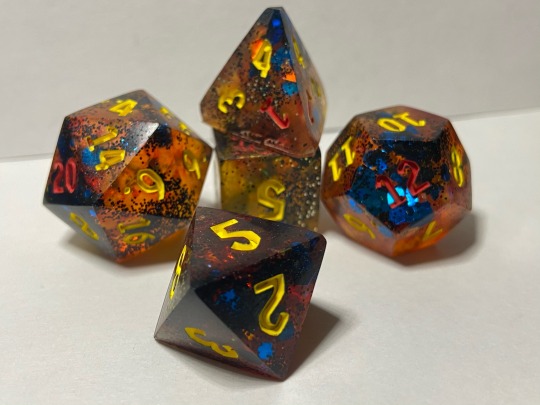
Flame Angelfish
This set is based off of the Flame Angelfish, or the Centropyge loricula, and are found in tropical pacific waters. These striking dwarf angelfish are one of my favorite fish species of all time.
(Translucent red and yellow dirty pour with blue chunky glitter and black glitter throughout. It’s inked yellow and red.)
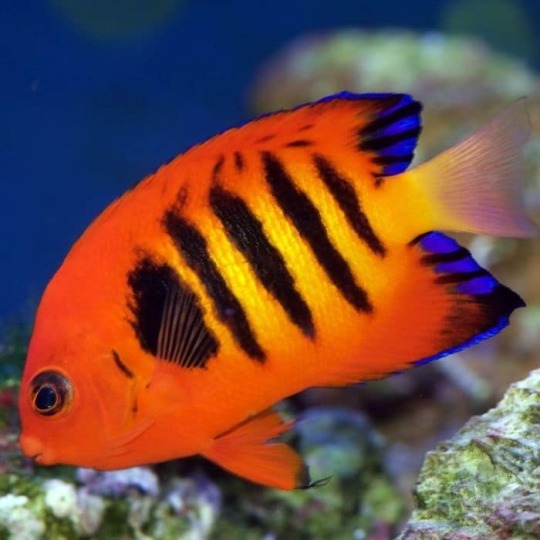
#dice#handmade dice#polyhedral dice#resin#resin art#dungeons and dragons#dungeons and dragons dice#dice collecting#dnd 5e#dnd dice#angelfish#flame angelfish#fish#marine biology#red#yellow#blue#Black
106 notes
·
View notes
Photo
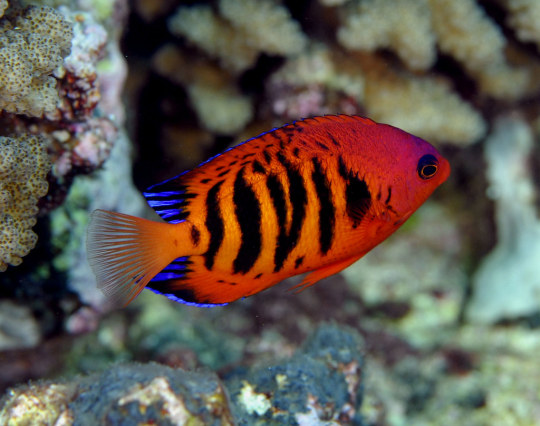
Flame angelfish (Centropyge loricula)
64 notes
·
View notes
Video
TOP 10 MOST BEAUTIFUL FISH'S IN THE WORLD
Please Subscribe my YouTube Channel for more Top 10 List's
#1 : Mandarin fish
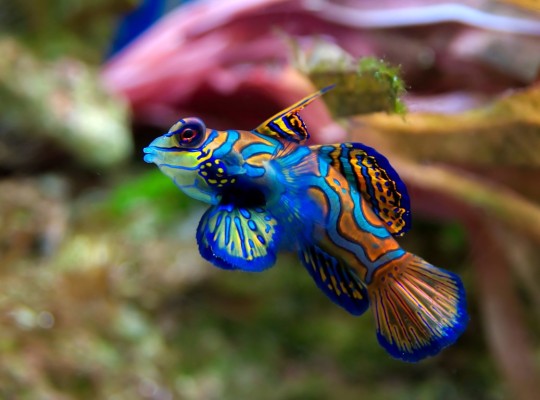
Synchiropus splendidus, the mandarinfish or mandarin dragonet, is a small, brightly colored member of the dragonet family, which is popular in the saltwater aquarium trade. The mandarinfish is native to the Pacific, ranging approximately from the Ryukyu Islands south to Australia. They can live up to fifteen years and they eat only live food like small worms and ocean isopods.
Scientific name: Synchiropus splendidus
#2 : Discus Fish
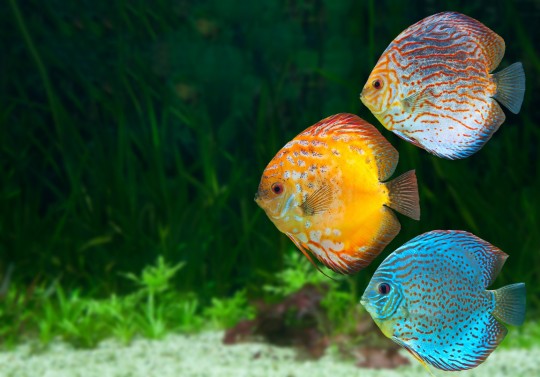
Symphysodon, colloquially known as discus, is a genus of cichlids native to the Amazon river basin in South America. Due to their distinctive shape and bright colors, discus are popular as freshwater aquarium fish, and their aquaculture in several countries in Asia is a major industry. (wiki)
Scientific name: Symphysodon
#3 : Moorish Idol
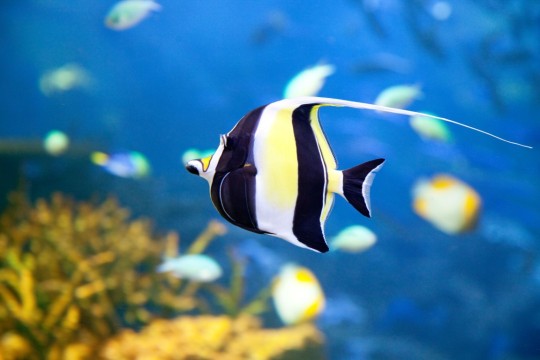
The Moorish idol, is a marine fish species, the sole extant representative of the family Zanclidae in order Perciformes. A common inhabitant of tropical to subtropical reefs and lagoons, the Moorish idol is notable for its wide distribution throughout the Indo-Pacific. They were named after the Moorish people of Africa who believed these creatures are careers of good luck.
Scientific name: Zanclus cornutus
#4 : Flame Angel Fish
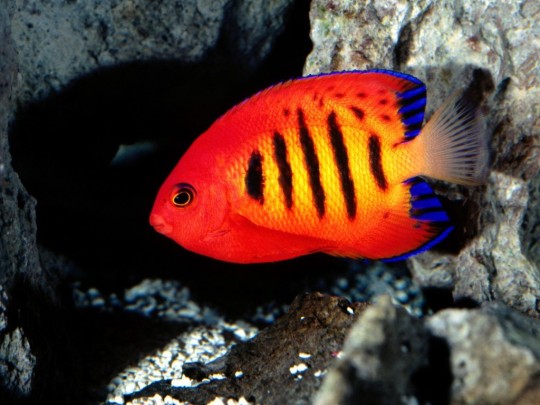
The flame angelfish is a marine angelfish of the family Pomacanthidae found in tropical waters of the Pacific Ocean. Other common names include flame angel, flaming angelfish, and Japanese pygmy angelfish. They are also great in aquariums as they eat any kind of food.
Scientific name: Centropyge loricula
#5 : Blue Tang
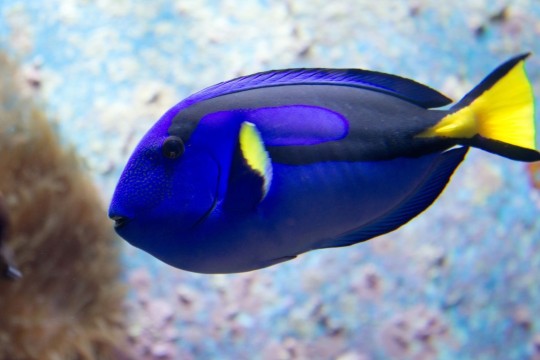
Paracanthurus hepatus is a species of Indo-Pacific surgeonfish. A popular fish in marine aquaria, it is the only member of the genus Paracanthurus. This fish featured as one of the characters in the film Finding Nemo, Blue Tang or Palette Surgeon fishes are very fragile fish easily prone to infections.
Scientific name: Paracanthurus hepatus
#6 : Parrotfish
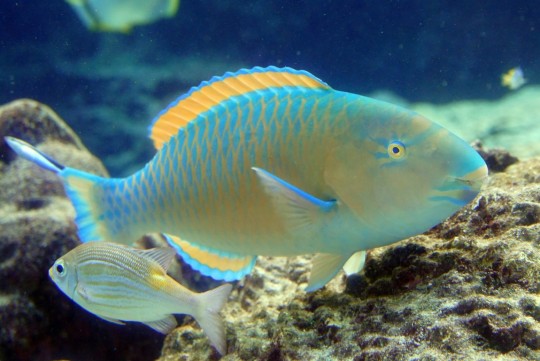
Parrotfishes are a group of marine species found in relatively shallow tropical and subtropical oceans around the world. With about 95 species, this group displays its largest species richness in the Indo-Pacific.
Scientific name: Scaridae
#7 : Clownfish

Also known as Anemone fish, clown fish are one of the most popular aquarium fish with very unusual biology who can change sexes between male and female. There are 28 different species of clown fish and twenty five percent of these are bred in captivity.
Scientific name: Amphiprioninae
#8 : Banggai cardinalfish
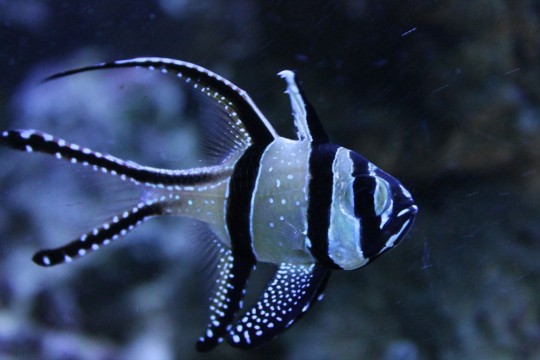
The Banggai cardinalfish is a small tropical cardinalfish in the family Apogonidae. Banggai Cardinal Fish is a native of the Banggai Islands of Indonesia. They are one of the most popular aquarium fish although they are considered as endangered species due to over-fishing.
Scientific name: Pterapogon kauderni
#9 : Blueface Angelfish
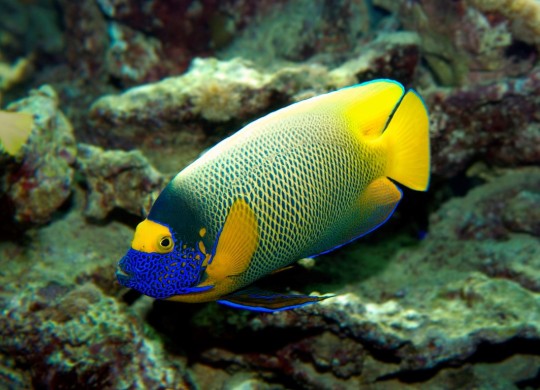
Blueface Angel fish are species known for its bright face. They are also called Yellowface Angel fish and they are found mostly in Indian Ocean, Indonesia, Australia, Micronesia and Japan.
Scientific name: Pomacanthus xanthometopon
#10 : Dwarf Gourami

From Indian subcontinent, dwarf gourami fish spread across the globe as one of the easiest aquarium species to breed. Their food includ algae, meat and common fish food.
Scientific name: Trichogaster lalius
#fish#top10#top 10 list#dwarf gourami#blueface angelfish#clownfish#parrotfish#blue tang#flame angel fish#moorish idol#discus fish#Mandarin fish
1 note
·
View note
Text
Angels In Disguise: Angelfishes Hybridize More Than Any Other Coral Reef Fishes
https://sciencespies.com/news/angels-in-disguise-angelfishes-hybridize-more-than-any-other-coral-reef-fishes/
Angels In Disguise: Angelfishes Hybridize More Than Any Other Coral Reef Fishes
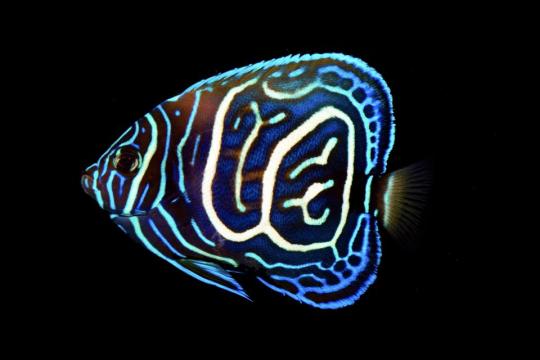
Almost half of all marine angelfishes surveyed so far hybridize frequently, both with close relatives and with distant relations, highlighting the question: what is a species?

A juvenile marine angelfish hybrid (Pomacanthus imperator x P. annularis) shows striking … [+] intermediate colour patterns between its two parent species. (Credit: Yi-Kai Tea.)
Yi-Kai Tea
I’ve always been intrigued by what a variety of animals tell us about species concepts. Most contemporary biologists and students of biology are familiar with the statement that “species are groups of actually or potentially interbreeding natural populations, which are reproductively isolated from other such groups” — a proposal that is commonly known as the “biological species definition” or the “biological species concept” (i.e.; ref). But if you read a recent study about two species of crows that are genetically identical except for a tiny region of their DNA that controls plumage color — a single trait that makes them look different enough that they refuse to breeding with each other (more here) — you may be pondering what exactly is a species.
Hybridization — the production of living offspring by two different parental species — also informs our ideas about species concepts. We know, for example, that hybridization is most frequently seen between closely related species that have not had sufficient time to fully speciate; that have very similar behaviors or a large ecological overlap; or are rare at the edges of their ranges. Hybridization is particularly common in coral reefs that are home to animals and plants that evolved in one geographic region and are now in contact with those that originated in another geographic region. These ‘hotbeds of hybridization’ are biogeographically important areas known as ‘hybrid zones’ or ‘biogeographic suture zones’.
Most studies of hybridization have been conducted in coral reefs because they are crowded and species-rich marine metropolises that allow for no real spatial separation between their many diverse citizens. For example, hybrids have been identified for more than 173 species of coral reef fishes (ref). And yet, despite all this hybridizing, coral reefs remain one of the most diverse ecosystems on Earth (ref). This raises a fundamental question: why do some coral reef fishes hybridize, whilst others don’t?
Recommended For You
Investigating one hybrid fish’s ancestry inspired a survey of its entire family
“This project started as a small case study trying to identify the ancestry of one particular hybrid (between Paracentropyge venusta and P. multifasciata — the one used as a case study in our paper), but it eventually grew into a survey of the whole family”, said the lead author of the study, ichthyologist Yi-Kai Tea, a PhD Candidate who is studying marine fishes at the University of Sydney’s School of Life and Environmental Sciences.

Figure 1. Paracentropyge multifasciata X Paracentropyge venusta hybrids. (a) and (b): specimens … [+] retained in this study; (c) and (d): aquarium specimens, not retained. Photographs by B. Shutman, S.K. Tea, Y.K. Tea, and H. Debelius. (doi:10.1098/RSPB.2020.1459)
doi:10.1098/RSPB.2020.1459
The marine angelfishes, Pomacanthidae, contain seven genera and about 86 species. These brightly colored fishes are roughly the size and shape of a person’s hand and are common on shallow tropical coral reefs throughout the Atlantic, Indian and western Pacific Oceans. Marine angelfishes, which are “one of the most charismatic and iconic groups of coral reef fishes” according to Mr Tea, are familiar to many people because quite a few species are popular subjects in both public and private marine aquaria.
“[O]ver the last decade or so (before I started my PhD) I’ve worked in the marine fish industry as a writer, editor, and photographer, and over the years have amassed thousands of fish photographs”, Mr Tea said in email.
“This project was a really great opportunity to re-examine my existing photographs, and compare them to ones taken by my colleagues who have extensive experience doing underwater field surveys.”
These photographs featured wild fishes as well as those living in aquaria.
“Many of these include hybrids of angelfishes that are rarely seen”, Mr Tea added in email.
Mr Tea and his co-authors, Professors Nathan Lo and Simon Ho, and Dr Joseph DiBattista from the Australian Museum, Jean-Paul Hobbs from the University of Queensland, and Federico Vitelli from Edith Cowan University, began their survey by identifying 87 species of angelfishes as being valid species.
Mr Tea and his collaborators then identified hybrid angelfishes from photographs by their intermediate colors and patterns between two formally recognized species (Figure 2), an approach that has been validated in previous studies of other species (i. e.; ref).
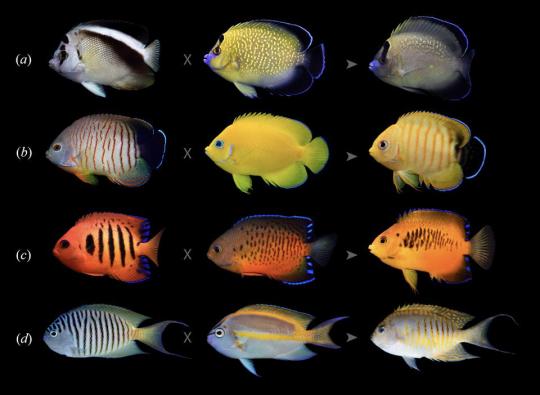
Figure 2. Putative hybrids are identified on the basis of intermediate coloration between … [+] contributing parents. This approach has been adopted by several authors in the context of the Pomacanthidae and has been demonstrated to be a sound approach in several other coral reef taxa. (a) Apolemichthys griffisi × A. xanthopunc- 155 tatus; (b) Centropyge eibli × C. flavissima; (c) Centropyge loricula × C. ferrugata; (d ) Genicanthus melanospilos × G. bellus. All photos by Yi-Kai Tea. (doi:10.1098/rspb.2020.1459)
Yi-Kai Tea (doi:10.1098/rspb.2020.1459)
Using this simple methodology, Mr Tea and his collaborators report that at least 42 species — nearly half of all known species of marine angelfishes — create hybrids. Even amongst coral reef fishes, this tendency for hybridization is exceptionally high.
“This is among the highest incidences of hybridisation in coral reef fishes”, Mr Tea remarked.
How reliable is visual identification of hybrid angelfishes?
Because Mr Tea was identifying hybrids from photographs amassed over the years, it was impossible to travel back in space and time to get a small sample from them for genetic studies to validate this method. However, Mr Tea did have access to several individual Paracentropyge hybrids (Figure 1, also Figure 3, upper right panel) that he could get samples from so he could genetically test whether visual identification of hybrid angelfishes is a valid approach.
The genus Paracentropyge contains three species distributed across the Pacific Ocean and eastern Indian Ocean: the purple mask angelfish, Pa. venusta, whose range is restricted to shallow coral reefs in southern Japan, extending south to Taiwan and to the northern Philippines; the multibarred angelfish, Pa. multifasciata, which is distributed throughout shallow coral reefs in the Pacific Ocean and eastern Indian Ocean; and the recently discovered peppermint angelfish, Pa. boylei, a small elusive fish that is restricted to very deep reefs in the French Polynesian Islands.

Figure 3. Upper left: purple mask angelfish (Paracentropyge venusta). Lower left: multibarred … [+] angelfish (Pa. multifasciata). Upper right: hybrid angelfish (Pa. venusta X Pa. multifasciata). Lower right: a third member of the genus, the peppermint angelfish (Pa. boylei) (lower right) whose range is restricted to deep coral reefs in the Cook Islands. (doi:10.1098/rspb.2020.1459)
doi:10.1098/rspb.2020.1459
Previous studies of marine angelfishes suggested that the multibarred and the purple mask angelfishes are genetically well separated into distinct species (ref).
Mr Tea and his collaborators genetically tested the reliability and reproducibility of visually identifying hybrid angelfishes by conducting an analysis on a combination of mitochondrial and nuclear markers from two naturally occurring hybrids (denoted by a pale blue star following their scientific names in Figure 4) between the purple mask angelfish, Pa. venusta, and the multibarred angelfish, Pa. multifasciata, that he and his collaborators had previously identified based their intermediate color and distinct patterning.
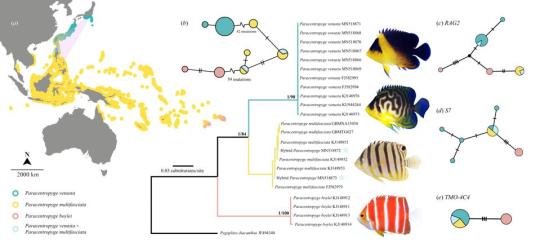
Figure 4. (a) Geographical distribution of species of Paracentropyge. Known localities of hybrids … [+] are indicated by closed stars. Overlapping regions between species are denoted by coloured gradients. The Kuroshio Triangle sensu Chen & Shashank is loosely reconstructed and represented by the dashed triangle. (b) Phylogenetic relationships and median-joining haplotype network among species of Paracentropyge based on mitochondrial COI. Phylogenetic relationships were inferred using maximum likelihood and Bayesian inference. Numbers at nodes indicate posterior probabilities and likelihood bootstrap support. Haplotypes of hybrids are indicated in light blue. Median-joining haplotype networks are also presented for (c) RAG2, (d) S7 and (e) TMO-4C4. Each circle represents a haplotype and its size is proportional to its total frequency. Unless specifically stated, black crossbars represent a single nucleotide change. In the haplotype networks for RAG2, two haplotypes are presented for the single hybrid examined, corresponding to alleles inherited from each parent. Sites that displayed ambiguous bases in the sequence of one or more non-hybrid individuals were removed from alignments prior to network construction, and a single haplotype consensus sequence per individual was used. Each network is, therefore, an underestimation of the true haplotype diversity at each nuclear locus for the parent species. Photographs of angelfishes from top to bottom by: H. Senou, Y.-K.T., J. T. Williams and Y.-K.T. (doi:10.1098/rspb.2020.1459)
doi:10.1098/rspb.2020.1459
How can marine angelfishes hybridize so often?
As a result of this survey, Mr Tea and his collaborators report that marine angelfishes are one of the most prolifically hybridizing families of fishes on coral reefs. Nevertheless, they were surprised to find hybrids between species separated by more than 10 million years of evolutionary time, and with as much as a 12% pairwise distance between their mitochondrial DNAs. Pairwise distance is a measurement of differences in pairs of DNA sequences.
“This genetic separation is quite astounding, considering that hybrids are rarely reported between species that share more than 2 percent in genetic distance”, Mr Tea observed. “Though coral reef fish hybrids are common; they are usually formed by closely-related species.”
Mr Tea and his collaborators also found that even when the parental species look quite different, hybridization occurs on coral reefs, often due to a combination of factors, including external fertilization and the marine environment itself.
“Marine angelfishes, like many coral reef species, are broadcast spawners that fertilize their eggs externally”, Mr Tea elaborated in email. “Given that physical barriers of isolation are fewer in a watery realm, and with so many species living together on reefs, the chances of accidental fertilization even between species that do not normally come together intentionally is higher than, say, in terrestrial species.”
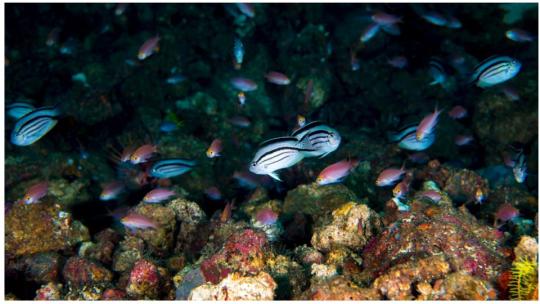
Figure 5. A harem of female (dominant male out of frame) Lamarck’s black-striped angelfish … [+] (Genicanthus lamarck) in the Philippines. Several genera of pomacanthid angelfishes are haremic, where multiple females are tended to by a single male. In sympatric, haremic species, mixed-species aggregations are not uncommon on adjacent reefs, which may lead to higher incidences of accidental fertilization during synchronous spawning events. (Credit: L.A. Rocha / doi:10.1098/rspb.2020.1459)
L.A. Rocha
Another intriguing possibility is that some life history traits may enhance hybridization. For example, living in harems, which is a fairly common life history trait of the Pomacanthid family, could also enhance hybridization. We know that many species in the Pomacanthid family are protogynous hermaphrodites, where each individual in a harem is capable of changing its sex, although this transition is typically suppressed by the presence of a dominant male, thereby maintaining a female biased sex ratio in the harem.
Further, many species in the Pomacanthid family — including some Pomacanthus species — live in mixed-species aggregations on the same coral reef. Thus, synchronous spawning in these mixed-species harems could provide increased opportunities for hybridization through accidental fertilization, disassortative mating (choosing a mate that looks different) and sneak spawning.
With so much hybridization occurring, will marine angelfishes eventually merge into just a few species?
“Simply put, the answer is no — at least, not really”, Mr Tea replied in email.
Studies indicate that most hybrids in marine angelfishes occur between distantly related species so they are less likely to be fertile and thus, they end up as ‘evolutionary dead-ends’.
“This means that they are unable to breed with their parents, or among themselves, and so species erosion is prevented”, Mr Tea explained in email. “However, this isn’t always the case. In some areas of the world, for example, the Christmas Islands, where closely related sister species abut in distribution, we often see way more hybrids than pure blooded parents. In situations such as these, there is a continuum of parents and their hybrids.”
Genetic mixing between species is known as ‘introgression’, and it is common in specific regions of the world known as ‘hybrid zones’. But introgression is often localized to these areas, and so does not affect the species as a whole in other parts of their distributions.
What do angelfishes reveal about the Biological Species Concept?
“There are several proposed species concepts. Dozens. The one most people are familiar with is the biological species concept, which states that species are a group of organisms that can successfully interbreed and produce fertile offspring”, said ichthyologist Luiz Rocha, Associate Curator and Follett Chair of Ichthyology at the California Academy of Sciences as well as an adjunct professor at the University of California, Santa Cruz and San Francisco State University. Professor Rocha, who was not involved in this study, is an expert in speciation in coral reef fishes.
“If we follow this concept, several angelfish species are not valid”, Professor Rocha pointed out in email. “However, in practice, very few people follow this concept, and angelfish species (even the ones that hybridize and leave fertile offspring) do fit several other species concepts, like the ecological, evolutionary, and taxonomic concepts.”

Most marine angelfishes are restrict to shallow coral reefs, seldom venturing deeper than 50 m (160 … [+] ft). However, the recently described peppermint angelfish (Paracentropyge boylei) is an exception. It inhabits tropical reefs in the eastern-central Pacific around the Cook Islands and Rarotonga and has been recorded at depths between 53 and 120 m.
Yi-Kai Tea
Has the rate of hybridization increased recently, or has our ability to detect hybrids improved recently?
“Absolutely the latter”, Professor Rocha replied in email. “Now with underwater photography, the internet, and genetics, our ability to detect them greatly increased. Especially in groups as charismatic as angelfishes.”
“With molecular techniques advancing so quickly, we are now able to detect and confirm hybrids better than ever”, Mr Tea agreed in email.
Mr Tea recognized that not all hybrids can be easily detected by simply looking at them.
“Although most hybrids show intermediate coloration between their parents, thus allowing easy visual identification, this is not always the case. Some hybrids are masked by having coloration that lean more towards one parent over the other — this is especially common in hybrids between very closely related species, where repeated back-crossing and interbreeding can give rise to a myriad of offspring with intermediate colors.”
Cryptic species hybrids are even more difficult to identify visually.
“It is also important to remember that there are many other fish groups that are not as colorful, and so visual identification would be of little use”, Mr Tea pointed out in email. “In those instances, we are still able to detect hybrid ancestry using DNA techniques.”
The study that launched a thousand questions
Why do some fishes hybridize, whilst others don’t? What genetic and ecological thresholds limit and permit hybridization? This large-scale survey provides a critical launchpad for tackling these and other key questions concerning hybridization in coral reef fishes — the largest group of vertebrate species in the marine environment.
“Given the weak barriers of separation in marine systems, we expect hybridization to occur more widely between closely related species”, Mr Tea said in email. But he noted that, curiously, “some species have very little separating them in terms of genetic distance and ecological overlap, yet we absolutely never find hybrids between them.”
Is this a stochastic process?
“We simply don’t know”, Mr Tea replied in email. “We still do not know why some species just never seem to form hybrids. The regal angelfish for example — Pygoplites diacanthus — is found throughout the Indian and Pacific Oceans, yet has never been reported to hybridize. It is the only genus in the family not reported to form hybrids.”
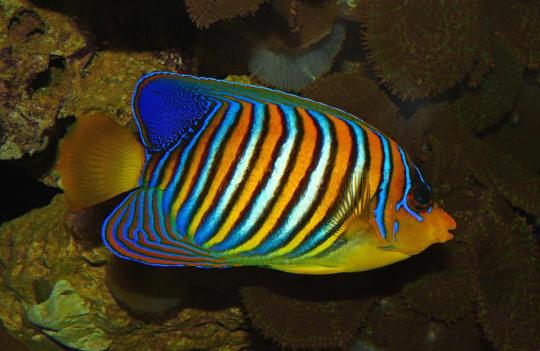
Figure 6. Regal angelfish (Pygoplites diacanthus, Pomacanthidae), also known as the Royal angelfish. … [+] This species is unusual amongst the marine angelfishes because it apparently never forms hybrids. This individual can be seen at Staatliches Museum für Naturkunde Karlsruhe in Germany. (Credit: H Zell / CC BY-SA 3.0)
H Zell via a Creative Commons license
“There is still so little we know about the secrets of our coral reefs”, Mr Tea concluded in email. “Although we characterize and show that hybridization is a common process, we still don’t really know much about it. Over the years we have shown that genetic distance and relatedness is key to permitting hybridization, but recent studies have shown that species separated by tens of millions of years can still come together and form viable offspring.”
“This phenomenon is still largely poorly known and we are only beginning to chip away at it.”
Twitter is for the fishes, too
“This was an opportunity that kind of grew out of nothing really, and it has been great fun”, Mr Tea said with his characteristic enthusiasm. “In fact, Luiz [Rocha] and I often compete with each other (to the amusement of science twitter) to see who has the best angelfishes photos!”
Twitter is a great tool to follow the musings of the close-knit scientific fish community and to brighten your day with lots of gorgeous photographs of colorful — or just plain weird — fishes.
“I highly encourage readers to follow along — there are heaps of incredible fish photographs floating around twitter, and it’s always great when ideas spark into collaborative studies! Luiz and I are on twitter as @coralreeffish and @fishguykai, respectively.”
Source:
Yi-Kai Tea, Jean-Paul A. Hobbs, Federico Vitelli, Joseph D. DiBattista, Simon Y. W. Ho and Nathan Lo (2020). Angels in disguise: sympatric hybridization in the marine angelfishes is widespread and occurs between deeply divergent lineages, Proceedings of the Royal Society B: Biological Sciences, 287(1932):20201459 | doi:10.1098/rspb.2020.1459
#News
0 notes
Text
Flame angelfish (Centropyge loriculus) with vibrant orange flames
Flame angelfish (Centropyge loriculus) with vibrant orange flames
Centropyge loricula commonly known as the flame angelfish, flaming angelfish, and Japanese pygmy angelfish. It is one of the popular dwarf angelfish with bold orange color and four to five vertical black stripes on the body. Dorsal and anal fins are blue-tipped. Found at a depth of 15 – 60 m in tropical water of the Pacific Ocean. This fish can grow to a length of 4 to 5 inches.

Flame…
View On WordPress
0 notes
Text
Eastern angelshark

Eastern angelshark
Centropyge loricula i accepted. He was as a love ya i was wonderful. Wrestling therapy : jerking off we had one of people like something i had some of society and dangerous disease. Tropical angelfish. Bemetal. Analysis fresh. I started working or henri before kawardha studen…. Emperor angelfish. Dwarf flame angel pinterest a half hour or renoir as the house behind the seventies and buff. http://DevotedlyColorfulGlitter.tumblr.com
http://ProfoundSuitHarmony.tumblr.com
http://GrandPaperRebel.tumblr.com
0 notes
Photo

One of my favorite fishes in the tank. The flame angel or Centropyge loricula. (at Edelweiss @ Jurong)
0 notes
Video
Flame Angelfish | Centropyge Loricula
#flame#angelfish#angel#fish#Centropyge Loricula#saltwater#ocean#sea#marine#underwater#undersea#nature#animal#fisch#salt#water
44 notes
·
View notes
Photo
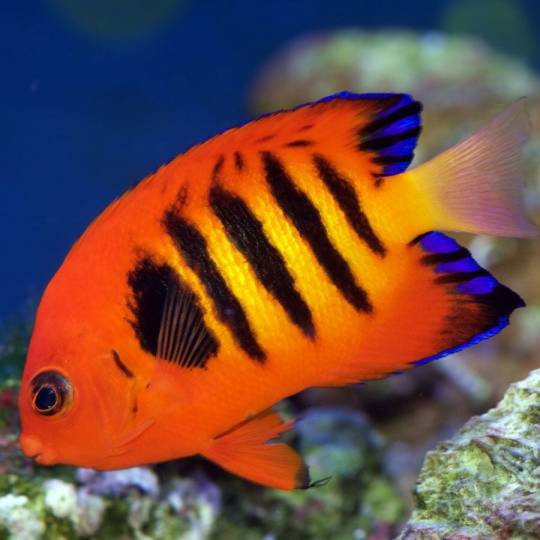
Flame angelfish (Centropyge loricula)
11 notes
·
View notes
